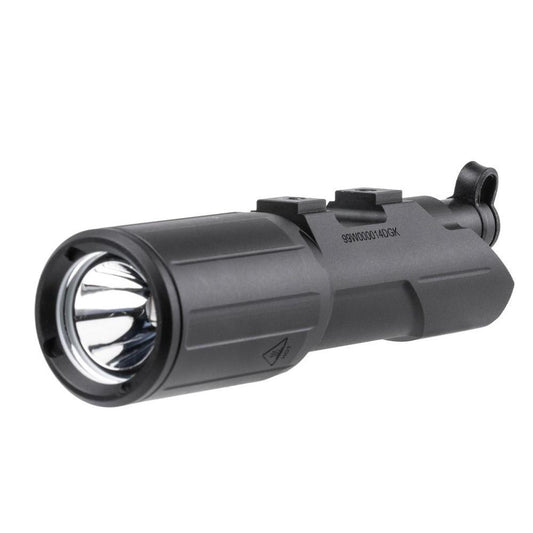

Illuminate your tactical scenarios with the Sig Sauer Foxtrot MSR Compact Rifle Mounted Weapon Light SOFR1CM0. Offering a powerful output of 1350 Lumens and 33000 Candela, this compact light enhances visibility in low-light conditions, providing a reliable solution for personal defense. Constructed from durable 6061 aluminum, it withstands the demands of tactical use while maintaining a lightweight profile. The integrated remote tape switch allows for seamless activation, featuring both momentary and latching modes for operational flexibility.
Designed for compatibility with M-LOK and Picatinny mounting systems, the Foxtrot MSR adapts to various setups, ensuring versatility in different tactical environments. It operates on a single 18350 lithium-ion battery, providing up to an hour of runtime. With included remote switch and two batteries, this light is ready out of the box, making it a reliable companion in critical situations.
Features:
- HIGH OUTPUT LIGHTING for exceptional visibility in low-light conditions.
- DURABLE CONSTRUCTION ensures reliability and longevity through rigorous use.
- VERSATILE MOUNTING options for different platforms, accommodating diverse needs.
- REMOTE SWITCH INCLUDED for easy operation without losing focus on your target.
- LITHIUM-ION POWERED with two batteries included for extended use.
- COMPACT DESIGN means it doesn't add bulk to your setup.
- USER-FRIENDLY CONTROLS allow for one-hand operation, enhancing ease of use.
- SCOUT MOUNT COMPATIBLE for added versatility in attaching to various systems.
Technical Specifications Table
| Feature | Specification |
|---|---|
| Output | 1350 Lumens |
| Candela | 33000 Candela |
| Battery Type | (1) 18350 Li-Ion Rechargeable |
| Runtime | Up to 1 Hour |
| Material | 6061 Aluminum |
| Mounting Options | M-LOK & Picatinny Rail |
What’s in the Box?
- Sig Sauer Foxtrot MSR Light
- Remote Tape Switch
- 2 x 18350 Lithium-Ion Batteries
- M-LOK Mounting Interface
- Picatinny Mounting Interface
Customer Reviews
"The Foxtrot MSR delivers outstanding brightness and is easy to mount. Love the convenience of the remote switch!"
"Perfect for my short-barreled rifle. The durability and performance are top-notch!"
FAQ
How does the Foxtrot MSR compare to other tactical lights? The Foxtrot MSR stands out with its high output and versatile mounting options, making it ideal for various tactical applications. Its construction from strong aluminum ensures it can withstand tough conditions.
Is it easy to maintain the Foxtrot MSR? Yes, the Foxtrot MSR requires minimal maintenance. Regularly check the battery and ensure the light is clean for optimal performance. The durable design protects against wear and tear.
Similar Models
If you're interested in exploring further, check out the entire range of SIG SAUER tactical lights, such as the FOXTROT-1X for enhanced versatility or the FOXTROT-2 for an adaptive lighting solution. Explore our complete collection for exceptional tactical gear tailored to your needs!
You May Also Like
Here’s some of our most similar products people are buying. Click to discover trending style.






